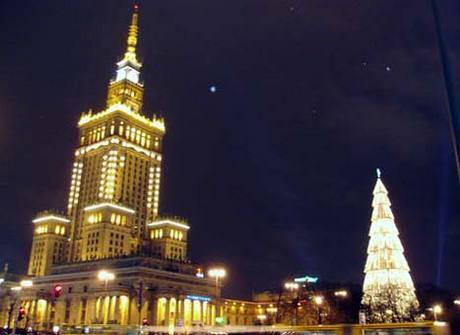Marshal Street
Rebuilding of Warsaw after World War II coincided with emergence of socialist realism. The facades of many buildings in this area show the uninspired architecture style of the communist area. Buildings are generally dull and it is difficult to distinguish one building from the other. However this area shows the remnants of Warsaw's communist past and in that sense it is very interesting.
In the heart of Warsaw is the Palace of Culture. This monolithic building was a "gift" from the Soviet Union to Warsaw. It was built in 1955 to the design of a Russian architect and resembles Moscow high-rises. Although it has 30 stories only - it was Europe's second largest building at that time.
Worth seeing in this area are: Warsaw Technical University, Warszawa hotel, Palace of Culture and Science, and PKO S.A Bank. All are located in the center of Warsaw along Marshall Street.
For many travellers, the area around Marshal Street will provide the first taste of this venerable city. This is where the main train station is situated, and the commercial district of Warsaw fans out between here and Solidarity Avenue to the north.
However, perhaps a first gulp would be a more appropriate expression than a first taste. With the towering exception of Venice (which provides the traveller with the visual equivalent of being handed a flute of champagne and a smoked salmon vol-au-vent) it is fair to say that the majority of European cities tend to engender a negative first impression if one is arriving by train. And Warsaw is no exception. This is more a 'there's your tomato in the face, now get on with your day' type welcome. Indeed many Varsovians hail Central Station as there number one love to hate destination.
However, one building that would make a a very fascinating subject for a study of socialist realist architecture is Joseph Stalin's colossal Palace of Culture. It is one of the first major landmarks that strikes you on on leaving the station and a worthy competitor for most loathed monument in the capital. This gargantuan, Gotham City-like tower shoots up from the centre of Warsaw. Raised after the Second World War during the era of Soviet domination, it remains one of the most controversial buildings in Poland, and it was only a whisker away from being pulled down when the Berlin Wall fell in '89.
Built between 1952 and 1955 as Joseph Stalin's "gift" to Warsaw, it was to resemble the Seven Sisters of Moscow, although to frustrated Varsovians it merely resembled the ugly reality of Soviet domination. After the "thaw" of 1956, the name of the building dropped Stalin's moniker and became merely the Palace of Culture and Science (Palac Kultury i Nauki), though it was occasionally referred to as "Peking" (from the Polish abbreviation, PKiN).
Today, the Palace of Culture (Palac Kultury) still stands as the tallest structure in the city, as well as in all of Poland. With 42 floors and over 234 metres (with 43 metres of spire alone), this epic still has the upper hand on all of its modern neighbours. At the moment, the building serves as an exhibition hall and office complex, as well as an FM and television broadcasting centre and cinema, theatre, museum, bookshop, and conference hall fitting 3,000 people.
Perhaps the highlight of the Palace of Culture for tourists is its observation deck on the 30th floor, from which you can see the whole city and the Vistula on a clear day. An old joke goes that the best views of Warsaw are available from the building - it's the only place in the city from where it could not be seen. In case you're having difficulty finding this megalith on Marshal Street (don't know how you could!) try asking for Plac Defilad - the largest square in Europe.
The Warsaw University of Technology (Polish: Politechnika Warszawska; literally, "Warsaw Polytechnic") is one of the leading institutes of technology in Poland, and one of the largest in Central Europe, employing 2,000 professors. The student body number 31,000 (as of 2004), mostly full-time. There are 17 faculties (divisions) covering almost all fields of science and technology. All are situated in Warsaw, except for one in Płock.
The Warsaw University of Technology has about 5,000 graduates per year. According to the 2008 "Rzeczpospolita" newspaper survey, engineers govern Polish companies. Warsaw Tech alums make up the highest percentage of Polish managers and executives. Every ninth president among the top 500 corporations in Poland is a graduate of the Warsaw University of Technology. Professor Kurnik, the rector of Warsaw Tech, explained that the school provides a solid basis for the performance of managers by equipping its students with an education at the highest level and a preparation with the necessary tools and information, including knowledge of foreign languages.
PKO Bank is Poland's largest bank. It was created on February 8th, 1919. The building of PKO Bank in Warsaw serves as national vault.
Whilst much of the area was not rebuilt to resemble the character of pre-war Warsaw, there are nevertheless echoes that hark back to that era. Marshal Street, which was one of the grandest streets of the capital, remains a thriving thoroughfare. It still has several fine buildings, particularly at the eastern end. On many of the streets leading off it there are some diverting places to be discovered, such as the old flagship Wedel patisserie on Szpitalna, whilst the famous Jablkowski brothers store has recently been brought back to life on Bracka.




